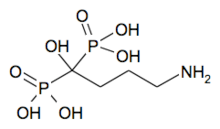
ALENDRONATE SODIUM
Structure

Product Description
Alendronate is a nitrogen-containing, second generation bisphosphonate. Bisphosphonates were first used to treat Paget’s disease in 1971. This class of medications is comprised of inorganic pyrophosphate analogues that contain non-hydrolyzable P-C-P bonds. Similar to other bisphosphonates, alendronate has a high affinity for bone mineral and is taken up during osteoclast resorption. Alendronate inhibits farnesyl pyrophosphate synthetase, one of the enzymes in the mevalonic acid pathway involved in producing isoprenoid compounds that are essential for post-translational modification of small guanosine triphosphate (GTP)-binding proteins, such as Rho, Ras and Rab. Inhibition of this process interferes with osteoclast function and survival. Alendronate is used for the treatment of osteoporosis and Paget’s disease.
Details |
|
|---|---|
Chemical Name |
ALENDRONATE SODIUM |
IUPAC Name |
sodium [4-amino-1-hydroxy-1-(hydroxy-oxido-phospho |
CAS Number |
121268-17-5 |
Molecular Formula |
C4H13NO7P2 |
Synonyms |
G-704650;ALENDRONATE SODIUM SALT;ALENDRONATE, SODIUM SALT TRIHYDRATE;ALENDRONATE SODIUM TRIHYDRATE;ALENDRONNATE SODIUM TRIHYDRATE;ALENDRONIC ACID, MONOSODIUM SALT, TRIHYDRATE;ADRONAT;4-AMINO-1-HYDROXYBUTYLIDINE-1,1-BISPHOSPHONATE SODIUM SALT TRIHYDRATE |
Application |
Inhibits bone resorption and increases bone densit |